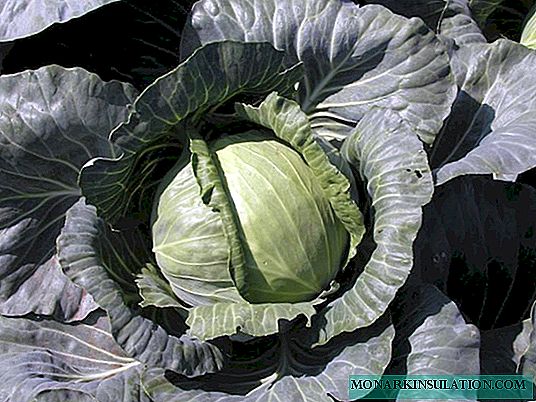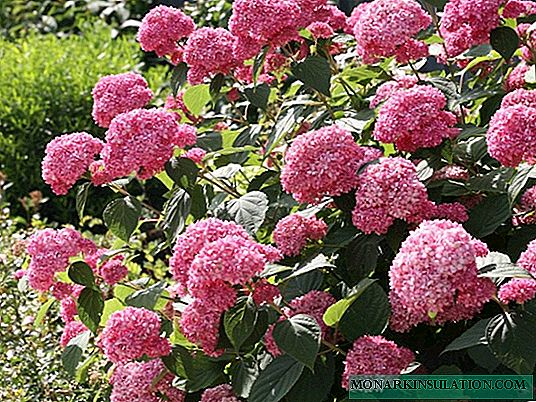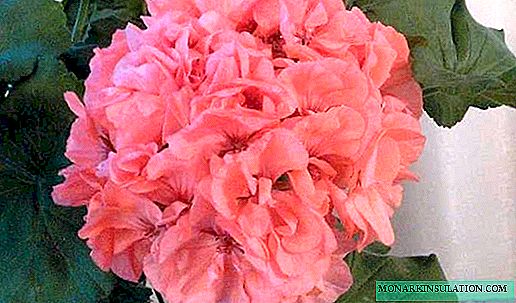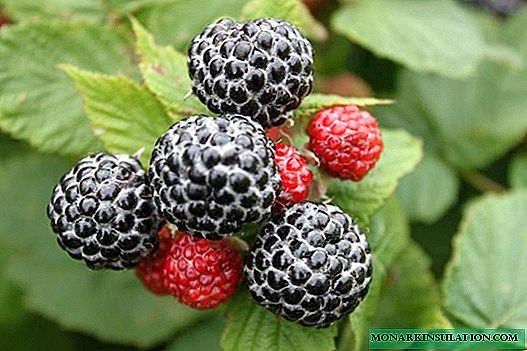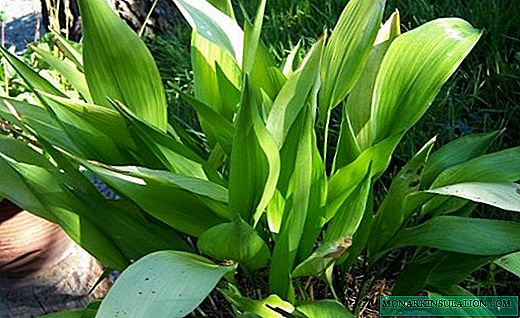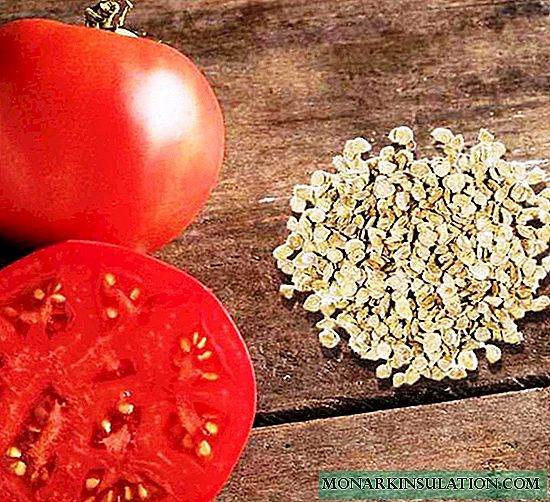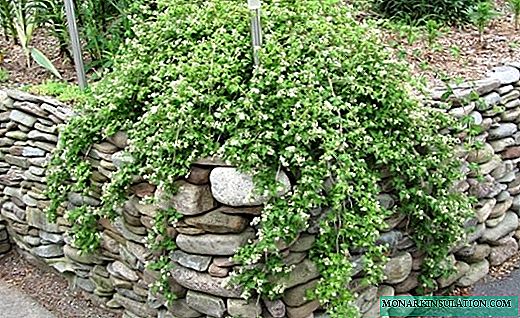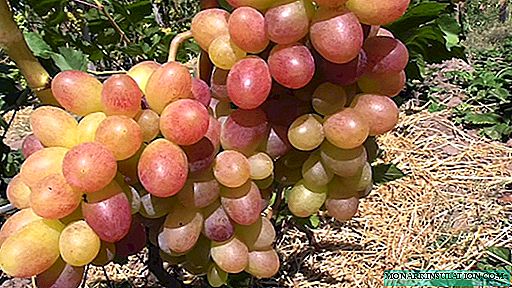
Lovers of grapes living in cold regions are looking for cold-resistant varieties that can also produce a crop for a short and cool summer. These conditions are fully met by the early ripening Tason variety, which is distinguished by abundant harvests and a very pleasant taste.
The history of growing Tason grapes
Tason table grapes obtained artificially on the basis of varieties Italy and Zoreva breeder T. A. Sonina at the All-Russian Research Institute of Viticulture and Winemaking them. J.I. Potapenko. This variety has not yet been included in the state register, however, many lovers actively grow it. Most successfully, it is cultivated in the conditions of the Rostov region, Crimea, Ukraine, but can grow and bear fruit even in the Moscow and Leningrad regions and in the north of Belarus.

Tason's popularity is largely due to its high productivity
Description and characteristics of the variety
Tason has a very early ripening period (100-110 days from the moment the buds open) to get the crop. This variety is easy to propagate - its cuttings are well rooted and combine perfectly with the stock.
Bushes are large, intensively growing. The lashes well (almost along the entire length) ripen by autumn. Fruitful shoots form a little more than half.
The leaves have five lobes, are strongly dissected and have a dark green color. The flowers are bisexual, so this variety does not need pollinators.

Tason flowers are well pollinated by bees
After flowering, clusters form on the vines, which, when poured, acquire a cylindrical shape. Their density is average, and the size is quite large, the mass reaches 0.5-0.8 kg, up to a maximum of 1.2 kg.
Oval-shaped berries, when fully ripe, have a white-pink color with a red tan on the lightened side. Grapes reach a size of 25 x 18 mm and a mass of 6-7 g. The skin is medium-density, when consumed, it is not felt. The pulp is quite dense, crunchy. There are seeds in the berries, but they are small and therefore almost not felt.
The taste is very pleasant, nutmeg aroma. High sugar content (19-21 g per 100 cm3) is compensated by a certain amount of acid (5-6 g / dm3), which ensures a harmonious taste.

In good light, the berries acquire a beautiful reddish tan.
Tason won the love of wine-growers not only in the southern regions, but also in the middle strip due to its advantages:
- very early ripening (last decade of July);
- high productivity (up to 40 clusters from 1 bush, that is 20-30 kg);
- great taste (8.2 points) and attractive appearance;
- long-term preservation of berries on the bush (about 2 months);
- resistance to wet weather (berries do not crack);
- resistance to transportation.
This variety is also not without cons:
- low resistance to fungal diseases (oidium, mildew, gray rot);
- relatively low frost resistance (up to -22 ° C).
Features of planting varieties Tason
Tason is suitable for growing in almost any climate. Even in the conditions of a short summer, he manages to produce a crop due to the short growing season.
In both warm and cold regions, it is advisable to plant Tason on the well-lit south side of the site. With a lack of sunlight, the berries will not get the proper color and remain greenish-white. The soil on the site should be fertile and moisture-permeable, in no case swampy.
Best of all, grapes feel protected by a fence or buildings that shelter bushes from cold winds.
Both spring and autumn are suitable for planting grapes. Since Tason is often grown in cold regions, spring planting (until mid-May) is more desirable for him. In this case, the seedlings will have time to develop well before the cold weather.
Tason is also planted with root crops, and planted on an adult stock. Cuttings for any of these methods are harvested in the fall, cutting out the ripened part of the vine with 4-5 eyes. For the winter, their sections are waxed, and the cuttings themselves are cleaned in a cellar or refrigerator.

For the best moisture preservation in cuttings, the sections for storage should be covered with paraffin
Vaccination is performed as follows:
- Select an adult bush stock, which is cut completely, leaving a small hemp.
- The cuttings are cut with a wedge and inserted into a cleft made with a sharp hatchet in the center of a stump-stock.
- The place of vaccination is tightened with a cloth and covered with clay.
Video: splitting vaccination
If you want the cuttings to take root, then they act like this:
- In the first half of February, they are taken out of the storehouse, the slices are refreshed.
- Put the lower part of the handle in a jar of water or in a pot (or a cut plastic bottle) with nutritious moist soil.
- In mid-April - early May, seedlings are transferred to a permanent place.
Video: growing grape seedlings from Chubuk
Planting grapes consists of successive steps:
- A week before planting, a pit is prepared with a depth and diameter of 0.8 m.
- At half the depth, the pit is filled with a nutrient mixture (fertile land, compost, potassium phosphorus salts), covered with a thin layer of earth.
- The seedling is set in a hole, trying not to break off the young white roots.
- Sprinkled with earth, compacted and watered.

To ensure drainage, a layer of gravel or broken brick is poured into the landing pit if necessary
Care Rules
Tason responds to good care, but there are no particular difficulties in growing this variety.
Cropping and shaping
Due to the strong growth, the vine bushes must be subjected to formation. The easiest way is a fan. You can also form a bush in the form of a two-shouldered cordon or grow it on an arch. In warm regions where grapes do not need to be covered for the winter, it can be cultivated in a standard form, like a tree.

It takes 3-4 years to get a fan-shaped bush
When cropping, you need to remember the basic rules:
- The optimal load for Tason is no more than 30-40 shoots on a bush.
- Each vine should be cut into 10-12 eyes.

Grapes with a high strain can be grown in warm regions
In autumn, grapes are cut, removing unripe parts of the vine, extra branches and thickening shoots. If the winter temperatures in the region fall below -22 ... -24 ° C, at the end of October the vines should be laid on the ground and covered. Suitable agrofabric, a layer of earth, straw or oilcloth.

To protect the grapes from frost, it is necessary to tie the vines, lay them on the ground and cover with straw
Watering
Watering grapes needs moderate - excess moisture will only hurt. Usually watered 3-4 times a season:
- After flowering.
- During the ripening period of berries.
- After the harvest.
- Before the onset of cold weather.
To better maintain moisture in the soil under the bushes, it is recommended to mulch the trunk circle with natural materials:
- peat
- sawdust
- mowed grass.
Top dressing
To get a plentiful harvest, you need to regularly fertilize the vineyard.
- The first root dressing is applied a few days after flowering.
- Then the plants are fed at the beginning of the ripening of berries - this helps to increase the average mass of clusters.
- The last top dressing is carried out in the fall with potassium salts, which increase the frost resistance of plants.
It is sometimes recommended to top dress at the very beginning of the growing season, but this can lead to the growth of the green mass of the bush to the detriment of the crop.
Organic matter is introduced in the form of slurry or infusion of chicken droppings, and rotted manure can also be used (used as a layer of mulch 7-10 cm thick). Do not forget that grapes are very useful trace elements:
- boric acid;
- manganese sulfates;
- zinc sulfates.
Grapes respond well to foliar top dressing. To do this, prepare aqueous solutions of fertilizers:
- nitrogen (ammonium nitrate 0.3%);
- phosphoric (superphosphate 5-7%);
- potash (potassium chloride 1.5%).
Top dressing can be combined with preventive spraying against fungal diseases.
Video: fertilizing and fertilizing grapes
Pest and Disease Control
Tason berries ripen at the height of summer and, naturally, attract birds and wasps. From birds, you can protect the vine bushes with a mesh (preferably rigid and finely meshed).
You can escape from wasps by setting insecticidal traps and destroying hornet's nests. If you are not afraid of extra work, it is better to wrap each brush in a gauze bag.
It should be remembered that beneficial insects can fall into insecticidal traps.

The mesh bag will successfully protect the grape crop from wasps
More dangerous than wasps, it may turn out to be a phylloxera - a microscopic aphid that affects both the ground parts of the plant and the root system. Against it, treatment with volatile carbon disulfide will help:
- With severe phylloxera lesion, a dosage of 300-400 cm is used3/ m2. This allows you to destroy pests, but the vineyard can die.
- To maintain planting, use a dosage of 80 cm3/ m2.

The defeat of grapes phylloxera is considered one of the most dangerous
The best method for preventing phylloxera is grafting on phylloxera-resistant stocks.
Tason is not very resistant to oidium, mildew and gray rot. Due to the early ripening of grapes, these diseases do not always "keep pace" with the harvest. But preventive treatment is necessary in any case. Copper preparations are suitable:
- Bordeaux liquid
- Captan
- Vitriol,
- Tsinos.
Harvesting, storage and use of crops
Tason begin to collect in the last decade of July. If the crop is very plentiful, you can safely leave some of the brushes on the bush - they hang until mid-September, without losing their taste.
Harvested grapes are stored in the refrigerator for about a month. Grapes suspended in a cool dark room lasts 2-3 months.
Tason is most often consumed fresh, but it can be processed by making:
- raisins,
- wine,
- the juice,
- compote,
- backmes.

Beckmes, or grape honey, is not only a tasty, but also a healthy treat
Grape growers reviews
I am absolutely amazed at the ability of this variety for long-term preservation in the bushes. Ripened on August 5 and now September 12 is hanging in a gauze bag. The taste only got brighter than the nutmeg. The berry is absolutely pink, as dense and juicy, I don’t notice any sluggishness, as happened with Krasa Nikopol today (but I did not try such sugar as in KN, a month after ripening, in a single table grade).
Evgeny Anatolyevich, Stavropol Territory//forum.vinograd.info/showthread.php?t=668
Tason in my vineyard is one of the most revered and beloved varieties of my family. At the same time, it is also my calling card at any exhibitions. This variety requires the selection, first of all, of a good warm and lighted place, competent and timely protection against diseases, and then handsome! As for the north of Belarus, I consider it to be the standard in taste and marketability for growing in the exhaust gas, but in the parietal culture, it produces excellent standard clusters weighing 500-600 g (in a sack greenhouse up to 800 g, it grows there too) with a beautiful yellow-pink appetizing berry 6-8 g, because in the north we are "not fat". Sugar content of about 17-19% is gaining quite well at low acidity, there are no particular problems with the maturation of vines, and yield is at an altitude. In addition, I noticed that the clusters hang pretty well for a long time on the bushes. But once again I emphasize the slack during cultivation does not forgive.
Vadim Tochilin, Novopolotsk, Belarus//vinforum.ru/index.php?topic=185.0
Tason, in comparison with the same Central Asians, very well "leaves" fungal diseases, in our conditions, with poor ventilation and untimely spraying, you can get an oidium on bunches, but in general, with ordinary, not excessive care, the variety shows itself very well (not Rizamat is not Shahin, in a word), so I think that even Tason is a pure European, but deserves attention.
Krasokhina, Novocherkassk//forum.vinograd.info/showthread.php?t=668
One drawback of Tason is the covering. This year the first harvest is -6 kg (in the past - the signal brush on a 2-year-old was not so impressive) the largest brush is 850 g., Color and taste are incomparable! But the wasps are still unripe biting. I’ll hang bags next year.
HITRO, city of Ochakov//forum.vinograd.info/showthread.php?t=668
The taste of Tason is EXCLUSIVE, nutmeg. Oidium - a little Yes. Mildew - no. Wasps - yes, very sweet and the shell is thin.
Belikova Galina, Volgograd//vinograd7.ru/forum/viewtopic.php?f=62&t=115
I have one fruiting bush of this variety. I plan to re-graft a couple more bushes for this variety. Tason is really a very early grape variety with a delicious berry. It is pollinated well, bunches of presentation, medium-dense, without pea. Ripe yellow-pink berry, sweet with delicate nutmeg. There were no fungal diseases on the thrones. After harvesting, it is advisable to process the green growth from mildew and oidium, because in September, Tason is usually affected by these diseases. This treatment preserves the deciduous cover, which contributes to better ripening of the vines and laying the harvest for next year.
Senchanin, Ukraine//vinograd777.ru/forum/showthread.php?t=288
Tason grapes are suitable for winegrowers from almost any Russian region. Of course, getting a good harvest will require some labor and time, but they will pay off with the excellent qualities of the berries.

